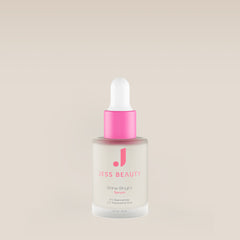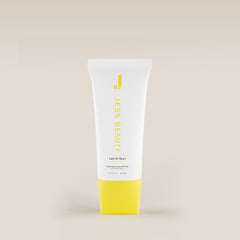Do you have oily skin, especially in the summer when your skin seems to produce even more sebum? Does it become difficult to control this situation? No worries! Many people struggle with excess oil and clogged pores, leading to persistent skin issues. The good news: There's a gentle, highly effective solution that's been a favorite for oily skin for years: salicylic acid.
At Jess Beauty, we understand how challenging oily skin can be. That’s why we created this guide to show you how to use salicylic acid in your skincare routine. Discover the benefits and see how it can help your skin look its best.
Is Salicylic Acid Good For Oily Skin?
We’ll go straight to the point – YES, DEFINITELY!
What Is Salicylic Acid?
Acids are becoming popular in skincare because they offer solutions for different skin types and concerns. Salicylic acid is a colorless compound widely known for its ability to treat blackheads and whiteheads. It effectively cleanses the face, removes dead skin cells, and unblocks pores. This acid is also used to clear bacteria and other debris, helping to manage acne and breakouts.
Derived from the bark of willow trees (Salix alba), salicylic acid has gained popularity alongside other hydroxy acids like glycolic and lactic acids. Each of these acids offers distinct benefits that deserve attention. If you want to know more about this specific ingredient, click here.
Let's dive in, how do you incorporate salicylic acid into an oily skin routine?
Who Can use salicylic acid?
Knowing who can benefit from salicylic acid is crucial. While salicylic acid is highly beneficial for many, it is not suitable for all skin types and may have drawbacks for some. Before using it, always follow these basic precautionary measures to ensure safe and effective use.
What Salicylic Acids Do For Oily Skin?
Salicylic acid addresses several skin problems, including:
Clogged Pores: It breaks down the oil and bacteria that accumulate on your face, keeping pores clean and preventing breakouts.
Exfoliation: As a keratolytic agent, salicylic acid effectively eliminates dead skin cells, leaving your skin cleaner and healthier.
Reduces Redness: Its anti-inflammatory properties reduce redness and inflammation in specific areas.
Controls Sebum: It regulates sebum production, helping to prevent acne by managing excess oil secretion.
Skin Disorders: It is used to treat keratosis pilaris, seborrheic dermatitis, and psoriasis.
How Does Salicylic Acid Work?
Not all acids are harmful. When used correctly, some acids can be very beneficial for our skin. Facial acids in appropriate concentrations can minimize the appearance of blemishes, eliminate scars, wrinkles, and even out skin tone.
Our skin regularly produces sebum (natural oil) and sheds dead skin cells. These can build up in pores and hair follicles, resulting in blackheads and whiteheads. These clogged pores frequently contain bacteria, causing irritation and pimples.
Salicylic acid is particularly effective at treating non-inflammatory acne, such as blackheads and whiteheads, and can help prevent future breakouts. Here’s how it works:
Penetrates Deeply: Salicylic acid exfoliates by penetrating deeply into the skin to cleanse clogged pores by breaking down dead skin cells and sebum.
Cleanses Skin: It removes dirt, opens congested pores, and reduces acne.
Bacteriostatic Property: While it doesn't kill bacteria, it limits their spread, reducing acne breakouts.
Incorporate Salicylic Acid into Oily Skin Routines
Salicylic acid is found in many skincare products like cleansers, scrubs, masks, and night creams. These come in different strengths, usually between 0.5% to 2%, so everyone can find one that suits their skin type and needs.
#JessBeautyTip: Always check the product information to pick the right type, strength, and usage frequency!
Face Wash
Use a face wash with salicylic acid (up to 2% concentration) for effective daily treatment. A salicylic acid face wash removes dead skin cells, allowing nourishing products to absorb better. If you don’t feel ready for this yet, you can use our Face Reset Cleanser , enriched with squalane, hyaluronic acid and coconut derived.

Serums
Salicylic acid serums are best applied during the evening routine for optimal effectiveness without interference from pollutants or UV rays. Avoid salicylic acid serums if you have dry or sensitive skin, as they can be too potent. Choose instead, our Shine Bright Serum with Niacinamide and Tranexamic acid that will nourish and transform gently the texture of your skin!
Topical Spot Treatment
Use topical spot treatments for blemishes or breakouts. These treatments contain high percentages of salicylic acid, which can cause dryness and flaking. Follow up with a hydrating serum containing hyaluronic acid to restore moisture, and if you haven’t incorporated it to your routine yet, Shine Bright it’s perfect for this step.
Professional Peels
For severe cystic acne, consider professional peels with medical-grade salicylic acid, performed by trained professionals. These peels speed up cell renewal and address problematic skin by removing dead skin cells that can cause breakouts.
SPF
Don't forget to use SPF everyday, especially if you have sensitive skin. Why? Salicylic acid works to control sebum, so it can make your skin more sensitive.
Choose between any of our SPF 50+ , if you want a matte touch with a gel consistency go for Let It Sun, but if you prefer an oil with a glowy touch, Sun Drops is your guy.
They both protect your skin from harmful sun rays that cause redness, inflammation, and more. And the best part? No white cast left behind!
Careful! Before Using Salicylic Acid make sure to...
Patch Test: Always do a patch test before using any product containing salicylic acid. Apply the product and wait for 20 minutes to check for redness, irritation, or discomfort.
Start Slowly: If using salicylic acid for the first time or if you have sensitive skin, start with a less concentrated product (around 0.5%) and gradually increase the concentration.
Avoid Layering with Retinol: Salicylic acid can cause dryness and works synergistically with other exfoliating agents like retinol. We recommend choosing between one of them, because when it comes to sensitive skin less is better!
Do Not Overdo It: Overusing salicylic acid can lead to dryness and weaken the skin’s barrier. Use it once a week or even once every two weeks, depending on your skin’s response.
Avoid If You Have Dry Skin: If you have dry skin, avoid using salicylic acid as it can worsen dryness and irritation, especially in winter.
How Long Does It Take to See Results?
The time it takes to see results depends on the product and your skin type. Typically, it takes about 3 to 4 weeks to notice improvements in your skin.
By following these guidelines, you can effectively incorporate salicylic acid into your oily skin routine and achieve clearer, healthier skin.









